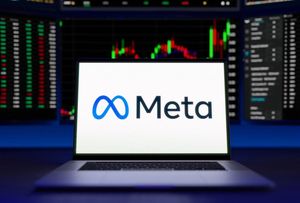
In a financial landscape increasingly characterized by volatility and a looming sense of economic deceleration, the iShares U.S. Treasury Bond ETF (NASDAQ: GOVT) is gaining significant traction among investors and analysts, positioning itself as a premier choice for those seeking stability, income, and diversification. With the Federal Reserve widely anticipated to embark on a series of interest rate cuts in late 2025, GOVT's appeal as a safe-haven asset with potential for capital appreciation is reaching new heights.
This renewed focus on U.S. Treasury bonds, encapsulated by the broad exposure offered by GOVT, reflects a broader market sentiment leaning towards caution. Investors are navigating a complex environment marked by slowing economic growth, persistent inflationary concerns, and geopolitical tensions, making the credit quality and liquidity of U.S. government debt particularly attractive. The ETF's ability to provide diversified exposure to the entire U.S. Treasury yield curve, from short-term bills to long-term bonds, makes it a versatile tool for various investment strategies.
Detailed Coverage: Navigating the Shifting Tides of Late 2025
The elevation of the iShares U.S. Treasury Bond ETF (NASDAQ: GOVT) to a "top pick" status is not an isolated event but rather a direct consequence of evolving economic conditions and monetary policy expectations as of late 2025. Financial analysts are increasingly highlighting GOVT's attributes, such as its low credit risk, potential for income generation, and role as a portfolio diversifier, particularly against equity market downturns. This recommendation comes amidst a backdrop of significant market anticipation for a pivot in the Federal Reserve's monetary policy.
The timeline leading to this moment is crucial. Throughout the first half of 2025, persistent signals of slowing economic growth and elevated recession risks began to solidify. Major financial institutions, including Goldman Sachs (NYSE: GS), had already raised their probabilities of a recession occurring within the year. Concurrently, the market started pricing in a high likelihood of the Federal Reserve initiating interest rate cuts. Specifically, expectations are firm for one to two rate cuts in the latter half of 2025, with a 25-basis-point reduction anticipated as early as the week of October 20, 2025, potentially followed by another in December. Historically, such rate-cutting cycles have often led to rising bond prices as yields fall, making existing bonds more valuable.
Key players in this scenario include BlackRock (NYSE: BLK), the issuer of the iShares suite of ETFs, which stands to benefit from increased inflows into GOVT. The Federal Reserve's policy decisions are, of course, central, as their actions directly influence bond yields and, consequently, GOVT's performance. Individual and institutional investors, along with the financial analysts and advisors recommending GOVT, are the primary stakeholders. Initial market reactions, while not a dramatic surge directly attributable to a single recommendation, have seen a general gravitation towards safe-haven assets, with U.S. Treasuries experiencing increased demand, reflected in GOVT's year-to-date NAV total return of 6.61% as of October 16, 2025. The ETF's attractive 30-day SEC yield of 3.88% further bolsters its appeal in this environment.
Corporate Impact: Winners and Losers in a Flight to Safety
The growing preference for the iShares U.S. Treasury Bond ETF (NASDAQ: GOVT) has distinct implications for various market participants, creating both winners and potential losers. At the forefront of the beneficiaries is BlackRock (NYSE: BLK), the world's largest asset manager and the issuer of the iShares family of ETFs. Increased investor interest and inflows into GOVT translate directly into higher assets under management (AUM) for BlackRock, bolstering its revenue from management fees. This strengthens BlackRock's position in the highly competitive ETF market and reinforces its dominance in passive investment solutions.
Investors prioritizing capital preservation and consistent income in an uncertain economic climate are also significant winners. By allocating to GOVT, they gain exposure to the safest credit quality assets globally, benefiting from the U.S. government's backing. The ETF's current attractive yields, coupled with the potential for capital appreciation if interest rates decline as expected, offer a compelling risk-adjusted return profile. Financial advisors and wealth managers who recommend GOVT to their clients are also positioned as winners, as they provide a valuable solution that aligns with current market conditions and client needs for stability.
Conversely, some segments of the market might experience headwinds. Equity-focused funds, particularly those heavily weighted towards growth stocks or sectors sensitive to economic downturns, could see reduced inflows or even outflows as investors shift capital towards safer fixed-income assets. While not a direct "loss," it represents a reallocation of investment capital away from riskier propositions. Furthermore, other bond ETFs with higher expense ratios or those tracking less liquid or riskier bond segments (e.g., corporate bonds, high-yield bonds) might find it challenging to compete with GOVT's cost-effectiveness and safety profile in a risk-off environment. Active bond managers could also face pressure, as the simplicity and low cost of a passive Treasury ETF like GOVT become increasingly appealing. The broad market exposure and diversification offered by GOVT, coupled with its intermediate duration of approximately 5.72%, make it a robust and accessible option that can divert capital from more complex or expensive alternatives.
Wider Significance: A Barometer of Market Sentiment
The ascendancy of the iShares U.S. Treasury Bond ETF (NASDAQ: GOVT) as a top investment pick in late 2025 is a powerful indicator of broader financial market trends and investor sentiment. This shift reflects a pervasive "flight to quality" – a classic response to economic uncertainty and heightened volatility. It underscores the market's conviction that the U.S. economy is indeed slowing, potentially heading into a recession, and that the Federal Reserve is poised to ease monetary policy.
This event fits squarely into the trend of investors seeking defensive positions. The traditional role of U.S. Treasuries as safe havens and portfolio diversifiers is being re-emphasized. While recent observations in 2025 have occasionally challenged the inverse correlation between stocks and bonds, with both asset classes declining simultaneously due to factors like tariff policy concerns and rising government debt, many experts still believe Treasuries will largely maintain their safe-haven role over the long term. The current environment, characterized by anticipated Fed rate cuts and slowing growth, reinforces the appeal of fixed-income assets.
The ripple effects extend across the financial ecosystem. Competitors, particularly other bond ETFs with different underlying assets or higher fees, may face pressure to justify their value proposition against GOVT's cost-efficiency (0.04% expense ratio) and robust credit quality. Active bond funds might also see their strategies scrutinized, as a simple, diversified Treasury ETF gains favor. Partners in the financial advisory space are increasingly incorporating such ETFs into client portfolios, adapting to the demand for stability. Regulatory and policy implications are significant, primarily stemming from the Federal Reserve's monetary policy decisions. The anticipated rate cuts are the central driver, signaling a belief that inflation is moderating enough to allow for easing, even amidst concerns about U.S. government debt issuance potentially pushing yields higher in the long run. Historically, periods of economic slowdown and anticipated Fed easing have consistently seen strong demand for U.S. Treasuries, making the current trend a familiar pattern in financial markets.
What Comes Next: Navigating the Future of Fixed Income
Looking ahead, the trajectory for the iShares U.S. Treasury Bond ETF (NASDAQ: GOVT) and the broader fixed-income market in late 2025 and beyond will be heavily influenced by several key factors. In the short term, the most significant catalyst will be the Federal Reserve's actions. Should the Fed proceed with the anticipated rate cuts in October and December 2025, as widely expected, GOVT is likely to experience further capital appreciation. Lower interest rates generally lead to higher bond prices, benefiting existing bondholders. This period could present opportunities for investors to lock in current attractive yields while also benefiting from price gains.
Long-term possibilities for GOVT remain positive, particularly if the economic slowdown persists or deepens, reinforcing the demand for safe assets. However, investors will need to monitor the evolving inflation outlook and the U.S. government's fiscal policy. While some forecasts suggest persistent inflationary pressures, which could keep long-term yields elevated, a significant moderation of inflation would further support the value of fixed-income assets. Conversely, increased issuance of U.S. Treasury debt to finance growing federal deficits could exert upward pressure on yields, potentially capping price appreciation for bonds.
Potential strategic pivots for investors might include adjusting their duration exposure within the Treasury market. While GOVT offers intermediate duration, investors seeking maximum sensitivity to falling rates might consider longer-duration Treasury ETFs, while those prioritizing capital preservation in a potentially volatile rate environment might favor shorter-duration options. Market opportunities will emerge from the potential for both income generation (current yields are attractive) and capital appreciation (due to anticipated rate cuts). Challenges include the aforementioned fiscal debt concerns and the ongoing debate about the traditional diversification benefits of bonds, especially if stock-bond correlations continue to behave atypically. Potential scenarios range from a "soft landing" where the Fed successfully engineers a mild slowdown, leading to gradual rate cuts and moderate bond gains, to a deeper recession, which would likely send a stronger "flight to safety" wave into Treasuries, boosting GOVT's performance significantly.
Comprehensive Wrap-up: Stability in a Sea of Change
In summary, the iShares U.S. Treasury Bond ETF (NASDAQ: GOVT) stands out as a compelling investment vehicle in late 2025, primarily due to its unparalleled safety, attractive income generation, and potential for capital appreciation amidst a backdrop of anticipated Federal Reserve rate cuts and heightened economic uncertainty. Its high credit quality, broad diversification across the U.S. Treasury yield curve, and low expense ratio make it an accessible and efficient way for investors to navigate a challenging market environment. GOVT's year-to-date performance and current yields underscore its immediate appeal.
Moving forward, the market is poised for continued volatility, with central bank actions and macroeconomic data dictating the pace and direction of bond yields. The Federal Reserve's anticipated easing cycle is a critical factor that could drive further demand and price appreciation for Treasury bonds. This period reinforces the lasting impact of U.S. Treasuries as foundational elements in diversified portfolios, offering a critical ballast against equity market fluctuations and economic downturns. While recent market dynamics have presented some questions about the traditional stock-bond correlation, the fundamental role of Treasuries as a safe haven remains largely intact for long-term investors.
Investors should watch closely for further announcements from the Federal Reserve regarding interest rate policy, paying particular attention to the language used to describe economic conditions and inflation. Key economic indicators, such as inflation reports, employment figures, and GDP growth, will also provide crucial insights into the health of the economy and the potential for future rate adjustments. Furthermore, monitoring the U.S. government's fiscal situation and Treasury debt issuance will be important, as these factors could influence long-term yield trends. For those seeking stability, income, and a strategic hedge in the coming months, GOVT offers a robust solution in an ever-evolving financial landscape.
This content is intended for informational purposes only and is not financial advice






